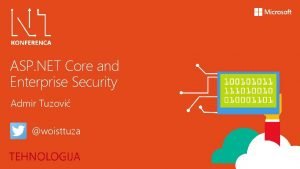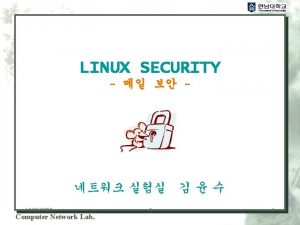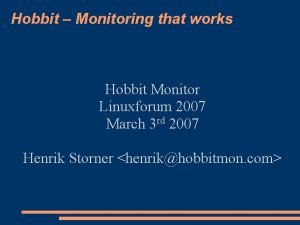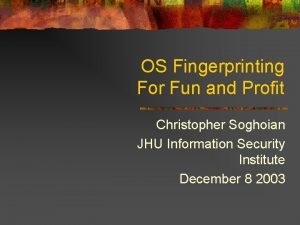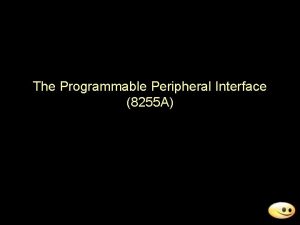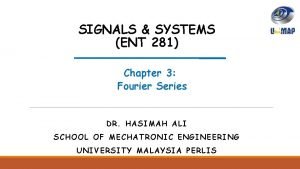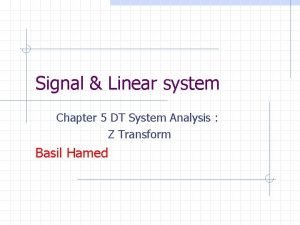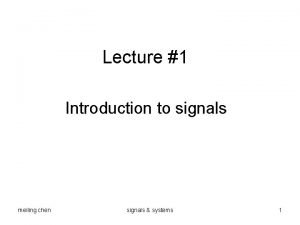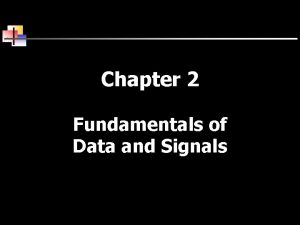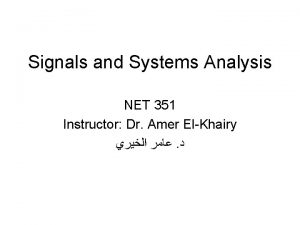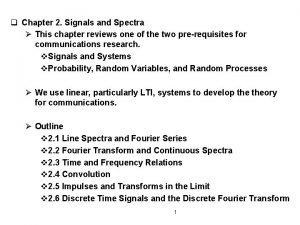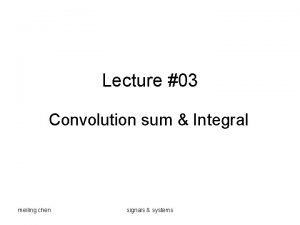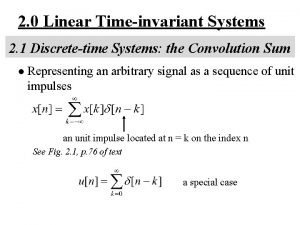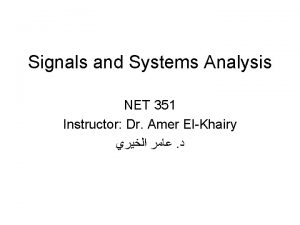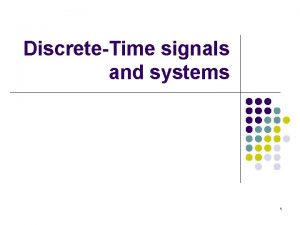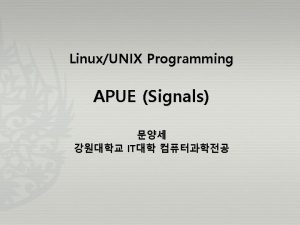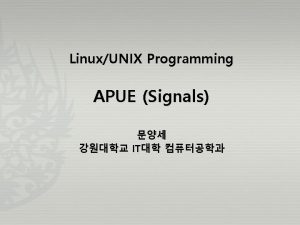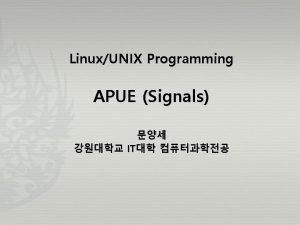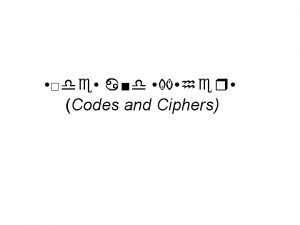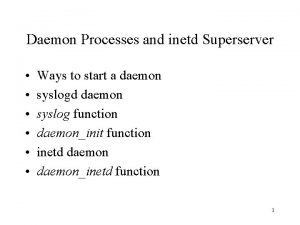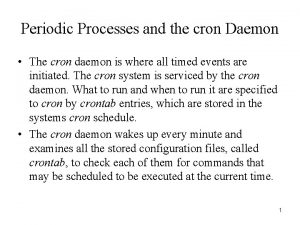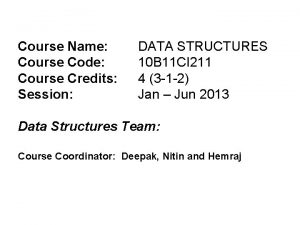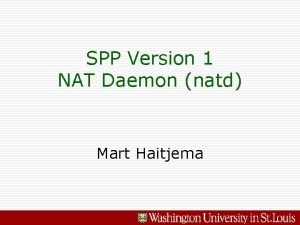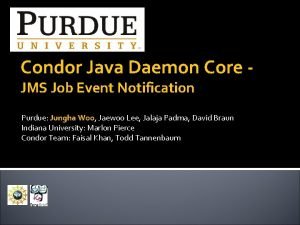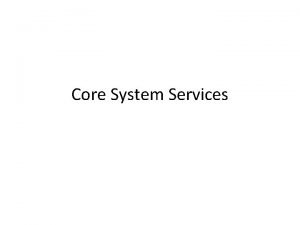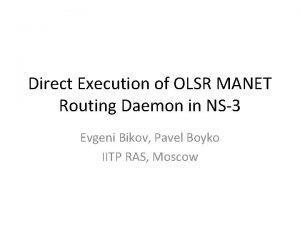Course code 10 CS 62 Signals and daemon











































- Slides: 43

Course code: 10 CS 62 Signals and daemon processes Engineered for Tomorrow Prepared by : Department of CSE

Engineered for Tomorrow Contents • • • Introduction The UNIX Kernel Support for Signals Signal Mask sigaction The SIGCHLD Signal and the waitpid Function The sigsetjmp and siglongjmp Functions Kill Alarm

Engineered for Tomorrow • • Interval Timers POSIX. lb Timers. Daemon Processes Introduction Daemon Characteristics Coding Rules Error Logging Client-Server Model.

Engineered for Tomorrow INTRODUCTION • Signals are software interrupts. Signals provide a way of handling asynchronous events: a user at a terminal typing the interrupt key to stop a program or the next program in a pipeline terminating prematurely. • When a signal is sent to a process, it is pending on the process to handle it. The process can react to pending signals in one of three ways: ü Accept the default action of the signal, which for most signals will terminate the process. ü Ignore the signal. The signal will be discarded and it has no affect whatsoever on the recipient process. ü Invoke a user-defined function. The function is known as a signal handler routine and the signal is said to be caught when this function is called.

Engineered for Tomorrow THE UNIX KERNEL SUPPORT OF SIGNALS • When a signal is generated for a process, the kernel will set the corresponding signal flag in the process table slot of the recipient process. • If the recipient process is asleep, the kernel will awaken the process by scheduling it. • When the recipient process runs, the kernel will check the process U-area that contains an array of signal handling specifications. • If array entry contains a zero value, the process will accept the default action of the signal. • If array entry contains a 1 value, the process will ignore the signal and kernel will discard it. • If array entry contains any other value, it is used as the function pointer for a user-defined signal handler routine.

Engineered for Tomorrow SIGNAL • The function prototype of the signal API is: #include <signal. h> void (*signal(int sig_no, void (*handler)(int)))(int); • The formal argument of the API are: • sig_no is a signal identifier like SIGINT or SIGTERM. • The handler argument is the function pointer of a userdefined signal handler function. • The following example attempts to catch the SIGTERM signal, ignores the SIGINT signal, and accepts the default action of the SIGSEGV signal. The pause API suspends the calling process until it is interrupted by a signal and the corresponding signal handler does a return:

Engineered for Tomorrow #include<iostream. h> #include<signal. h> /*signal handler function*/ void catch_sig(int sig_num) { signal (sig_num, catch_sig); cout<<”catch_sig: ”<<sig_num<<endl; } /*main function*/ int main() { signal(SIGTERM, catch_sig); signal(SIGINT, SIG_IGN); signal(SIGSEGV, SIG_DFL); pause( ); /*wait for a signal interruption*/ }

Engineered for Tomorrow SIGNAL MASK • A process initially inherits the parent’s signal mask when it is created, but any pending signals for the parent process are not passed on. • A process may query or set its signal mask via the sigprocmask API: #include <signal. h> int sigprocmask(int cmd, const sigset_t *new_mask, sigset_t *old_mask); Returns: 0 if OK, 1 on error • The new_mask argument defines a set of signals to be set or reset in a calling process signal mask, and the cmd argument specifies how the new_mask value is to be used by the API.

Engineered for Tomorrow • If the actual argument to new_mask argument is a NULL pointer, the cmd argument will be ignored, and the current process signal mask will not be altered. • If the actual argument to old_mask is a NULL pointer, no previous signal mask will be returned. • The sigset_t contains a collection of bit flags.

Engineered for Tomorrow The BSD UNIX and POSIX. 1 define a set of API known as sigsetops functions:

Engineered for Tomorrow • The sigemptyset API clears all signal flags in the sigmask argument. • The sigaddset API sets the flag corresponding to the signal_num signal in the sigmask argument. • The sigdelset API clears the flag corresponding to the signal_num signal in the sigmask argument. • The sigfillset API sets all the signal flags in the sigmask argument. • [ all the above functions return 0 if OK, -1 on error ] • The sigismember API returns 1 if flag is set, 0 if not set and -1 if the call fails.

Engineered for Tomorrow • A process can query which signals are pending for it via the sigpending API: #include<signal. h> int sigpending(sigset_t* sigmask); Returns 0 if OK, -1 if fails. • The sigpending API can be useful to find out whether one or more signals are pending for a process and to set up special signal handling methods for these signals before the process calls the sigprocmask API to unblock them.

Engineered for Tomorrow • The following example reports to the console whether the SIGTERM signal is pending for the process: #include<iostream. h> #include<stdio. h> #include<signal. h> int main() { sigset_t sigmask; sigemptyset(&sigmask); if(sigpending(&sigmask)==-1) perror(“sigpending”); else cout << “SIGTERM signal is: ” << (sigismember(&sigmask, SIGTERM) ? “Set” : “No Set”) << endl; }

Engineered for Tomorrow • In addition to the above, UNIX also supports following APIs for signal mask manipulation: #include<signal. h> • int sighold(int signal_num); • int sigrelse(int signal_num); • int sigignore(int signal_num); • int sigpause(int signal_num);

SIGACTION Engineered for Tomorrow • The sigaction API blocks the signal it is catching allowing a process to specify additional signals to be blocked when the API is handling a signal. • The sigaction API prototype is: #include<signal. h> int sigaction(int signal_num, struct sigaction* action, struct sigaction* old_action); Returns: 0 if OK, 1 on error • The struct sigaction data type is defined in the <signal. h> header as: struct sigaction { void (*sa_handler)(int); sigset_t sa_mask; int sa_flag; }

Engineered for Tomorrow • The following program illustrates the uses of sigaction: #include<iostream. h> #include<stdio. h> #include<unistd. h> #include<signal. h> void callme(int sig_num) { cout<<”catch signal: ”<<sig_num<<endl; } int main(int argc, char* argv[]) { sigset_t sigmask; struct sigaction, old_action; sigemptyset(&sigmask);

Engineered for Tomorrow if(sigaddset(&sigmask, SIGTERM)==-1 || sigprocmask(SIG_SETMASK, &sigmask, 0)==-1) perror(“set signal mask”); sigemptyset(&action. sa_mask); sigaddset(&action. sa_mask, SIGSEGV); action. sa_handler=callme; action. sa_flags=0; if(sigaction(SIGINT, &action, &old_action)==1) perror(“sigaction”); pause(); cout<<argv[0]<<”existsn”; return 0; }

Engineered for Tomorrow THE SIGCHLD SIGNAL AND THE waitpid API • When a child process terminates or stops, the kernel will generate a SIGCHLD signal to its parent process. Depending on how the parent sets up the handling of the SIGCHLD signal, different events may occur: v Parent accepts the default action of the SIGCHLD signal: o SIGCHLD does not terminate the parent process. o Parent process will be awakened. o API will return the child’s exit status and process ID to the parent. o Kernel will clear up the Process Table slot allocated for the child process. o Parent process can call the waitpid API repeatedly to wait for each child it created.

Engineered for Tomorrow v Parent ignores the SIGCHLD signal: o SIGCHLD signal will be discarded. o Parent will not be disturbed even if it is executing the waitpid system call. o If the parent calls the waitpid API, the API will suspend the parent until all its child processes have terminated. o Child process table slots will be cleared up by the kernel. o API will return a -1 value to the parent process. v Process catches the SIGCHLD signal: o The signal handler function will be called in the parent process whenever a child process terminates. o If the SIGCHLD arrives while the parent process is executing the waitpid system call, the waitpid API may be restarted to collect the child exit status and clear its process table slots. o Depending on parent setup, the API may be aborted and child process table slot not freed.

Engineered for Tomorrow THE sigsetjmp AND siglongjmp APIs • The function prototypes of the APIs are: #include <setjmp. h> int sigsetjmp(sigjmp_buf env, int savemask); int siglongjmp(sigjmp_buf env, int val); • The sigsetjmp and siglongjmp are created to support signal mask processing. • Specifically, it is implementation-dependent on whether a process signal mask is saved and restored when it invokes the setjmp and longjmp APIs respectively.

Engineered for Tomorrow KILL • A process can send a signal to a related process via the kill API. This is a simple means of inter-process communication or control. The function prototype of the API is: #include<signal. h> int kill(pid_t pid, int signal_num); Returns: 0 on success, -1 on failure.

Engineered for Tomorrow • The signal_num argument is the integer value of a signal to be sent to one or more processes designated by pid. The possible values of pid and its use by the kill API are: The UNIX kill command invocation syntax is: Kill [ -<signal_num> ] <pid>. . . Where signal_num can be an integer number or the symbolic name of a signal. <pid> is process ID.

Engineered for Tomorrow ALARM • The alarm API can be called by a process to request the kernel to send the SIGALRM signal after a certain number of real clock seconds. • The function prototype of the API is: #include<signal. h> • Unsigned int alarm(unsigned int time_interval); Returns: 0 or number of seconds until previously set alarm

Engineered for Tomorrow • The alarm API can be used to implement the sleep API: #include<signal. h> #include<stdio. h> #include<unistd. h> void wakeup( ) { ; } unsigned int sleep (unsigned int timer ) { struct sigaction; action. sa_handler=wakeup; action. sa_flags=0; sigemptyset(&action. sa_mask); if(sigaction(SIGALARM, &action, 0)==-1) { perror(“sigaction”); return -1; } (void) alarm (timer); (void) pause( ); return 0; }

Engineered for Tomorrow INTERVAL TIMERS • The interval timer can be used to schedule a process to do some tasks at a fixed time interval, to time the execution of some operations, or to limit the time allowed for the execution of some tasks. • The following program illustrates how to set up a real-time clock interval timer using the alarm API: #include<stdio. h> #include<unistd. h> #include<signal. h> #define INTERVAL 5 void callme(int sig_no) { alarm(INTERVAL); /*do scheduled tasks*/ }

Engineered for Tomorrow main() { struct sigaction; sigemptyset(&action. sa_mask); action. sa_handler=(void(*)( )) callme; action. sa_flags=SA_RESTART; if(sigaction(SIGALARM, &action, 0)==-1) { perror(“sigaction”); return 1; } if(alarm(INTERVAL)==-1) perror(“alarm”); else while(1) { /*do normal operation*/ } return 0; }

Engineered for Tomorrow • In addition to alarm API, UNIX also invented the setitimer API, which can be used to define up to three different types of timers in a process: v Real time clock timer v Timer based on the user time spent by a process v Timer based on the total user and system times spent by a process • The getitimer API is also defined for users to query the timer values that are set by the setitimer API. The setitimer and getitimer function prototypes are: #include<sys/time. h> int setitimer(int which, const struct itimerval * val, struct itimerval * old); int getitimer(int which, struct itimerval * old);

Engineered for Tomorrow The possible values and the corresponding timer types of which arguments are: The struct itimerval datatype is defined as: struct itimerval { struct timeval it_value; /*current value*/ struct timeval it_interval; /* time interval*/ }; The setitimer and getitimer APIs return a zero value if they succeed or a -1 value if they fail

Engineered for Tomorrow POSIX. 1 b TIMERS • POSIX. 1 b defines a set of APIs for interval timer manipulations. The POSIX. 1 b timers are more flexible and powerful than are the UNIX timers in the following ways: v. Users may define multiple independent timers per system clock. v The timer resolution is in nanoseconds. v Users may specify the signal to be raised when a timer expires. v The time interval may be specified as either an absolute or a relative time.

Engineered for Tomorrow The POSIX. 1 b APIs for timer manipulations are:

Engineered for Tomorrow

Engineered for Tomorrow INTRODUCTION Daemons are processes that live for a long time. They are often started when the system is bootstrapped and terminate only when the system is shut down. DAEMON CHARACTERISTICS The characteristics of daemons are: v. Daemons run in background. v Daemons have super-user privilege. v Daemons don’t have controlling terminal. v Daemons are session and group leaders.

Engineered for Tomorrow CODING RULES • Call umask to set the file mode creation mask to 0. • Call fork and have the parent exit. • Call setsid to create a new session. • Change the current working directory to the root directory. • Unneeded file descriptors should be closed • Some daemons open file descriptors 0, 1, and 2 to /dev/null so that any library routines that try to read from standard input or write to standard output or standard error will have no effect.

Engineered for Tomorrow Example Program: #include <unistd, h> #include <sys/types. h> #include <fcntl. h> int daemon_initialise( ) { pid_t pid; if (( pid = for() ) < 0) return – 1; else if ( pid != 0) exit(0); /* parent exits */ /* child continues */ setsid( ); chdir(“/”); umask(0); return 0; }

ERROR LOGGING Engineered for Tomorrow • One problem a daemon has is how to handle error messages. • It can't simply write to standard error, since it shouldn't have a controlling terminal. • A central daemon error-logging facility is required.

Engineered for Tomorrow • There are three ways to generate log messages: v Kernel routines can call the log function. These messages can be read by any user process that opens and reads the /dev/klog device. v Most user processes (daemons) call the syslog(3) function to generate log messages. This causes the message to be sent to the UNIX domain datagram socket /dev/log. v A user process on this host, or on some other host that is connected to this host by a TCP/IP network, can send log messages to UDP port 514. Note that the syslog function never generates these UDP datagrams: they require explicit network programming by the process generating the log message.

Engineered for Tomorrow • Normally, the syslogd daemon reads all three forms of log messages. • On start-up, this daemon reads a configuration file, usually /etc/syslog. conf, which determines where different classes of messages are to be sent. • For example, urgent messages can be sent to the system administrator (if logged in) and printed on the console, whereas warnings may be logged to a file. #include <syslog. h> void openlog(const char *ident, int option, int facility); void syslog(int priority, const char *format, . . . ); void closelog(void); int setlogmask(int maskpri);

Engineered for Tomorrow SINGLE-INSTANCE DAEMONS • Some daemons are implemented so that only a single copy of the daemon should be running at a time for properation. • The file and record-locking mechanism provides the basis for one way to ensure that only one copy of a daemon is running. • If each daemon creates a file and places a write lock on the entire file, only one such write lock will be allowed to be created. • Successive attempts to create write locks will fail, serving as an indication to successive copies of the daemon that another instance is already running.

Engineered for Tomorrow • File and record locking provides a convenient mutual -exclusion mechanism. • If the daemon obtains a write-lock on an entire file, the lock will be removed automatically if the daemon exits. • This simplifies recovery, removing the need for us to clean up from the previous instance of the daemon.

Engineered for Tomorrow DAEMON CONVENTIONS • If the daemon uses a lock file, the file is usually stored in /var/run. The daemon might need superuser permissions to create a file here. The name of the file is usually name. pid, where name is the name of the daemon or the service. For example, the name of the cron daemon's lock file is /var/run/crond. pid. • If the daemon supports configuration options, they are usually stored in /etc. The configuration file is named name. conf, where name is the name of the daemon or the name of the service. For example, the configuration for the syslogd daemon is /etc/syslog. conf.

Engineered for Tomorrow • Daemons can be started from the command line, but they are usually started from one of the system initialization scripts (/etc/rc* or /etc/init. d/*). • If a daemon has a configuration file, the daemon reads it when it starts, but usually won't look at it again. If an administrator changes the configuration, the daemon would need to be stopped and restarted to account for the configuration changes. To avoid this, some daemons will catch SIGHUP and reread their configuration files when they receive the signal.

Engineered for Tomorrow CLIENT-SERVER MODEL • In general, a server is a process that waits for a client to contact it, requesting some type of service. • In one-way communication between the client and the server, the client sends its service request to the server; the server sends nothing back to the client. • In two-way communication between a client and a server, the client sends a request to the server, and the server sends a reply back to the client.

Engineered for Tomorrow
 Animals and human language chapter 2
Animals and human language chapter 2 What is informative signals
What is informative signals Communicative and informative signals
Communicative and informative signals Ntk daemon
Ntk daemon Mailer-daemon 스팸
Mailer-daemon 스팸 Lemon daemon
Lemon daemon Daemon x machina memory usage
Daemon x machina memory usage Passive os fingerprinting daemon
Passive os fingerprinting daemon Code commit code build code deploy
Code commit code build code deploy Course title and course number
Course title and course number Disadvantages of cavity wall
Disadvantages of cavity wall Course interne course externe
Course interne course externe Course code example
Course code example Wveis course code manual
Wveis course code manual Course code example
Course code example Schoolcashonline dpcdsb
Schoolcashonline dpcdsb Cricos course code deakin university
Cricos course code deakin university Agnostisim
Agnostisim Wveis course code manual
Wveis course code manual Difference between source code and machine code
Difference between source code and machine code Linguistic repertoire example
Linguistic repertoire example How many bit data bus buffer is used in 8255
How many bit data bus buffer is used in 8255 Exponential fourier series coefficients
Exponential fourier series coefficients Signals and systems oppenheim solutions chapter 5
Signals and systems oppenheim solutions chapter 5 Shifting and scaling of signals
Shifting and scaling of signals Emergency stop crane hand signal
Emergency stop crane hand signal Beacon
Beacon Data and signals
Data and signals Flourescent optic yellow signs
Flourescent optic yellow signs Signs signals and roadway markings
Signs signals and roadway markings Fundamentals of data and signals
Fundamentals of data and signals Precedence rule in signals and systems
Precedence rule in signals and systems Pavement markings drivers ed
Pavement markings drivers ed Convolution sum in signals and systems
Convolution sum in signals and systems Line spectrum in signals and systems
Line spectrum in signals and systems Convolution sum signals and systems
Convolution sum signals and systems Guide and international signs
Guide and international signs Signs signals and roadway markings
Signs signals and roadway markings Introduction to signals and systems
Introduction to signals and systems Convolution sum in signals and systems
Convolution sum in signals and systems Signals that tell your mind and body how to react.
Signals that tell your mind and body how to react. Signals and systems
Signals and systems Pps emergency signals and actions
Pps emergency signals and actions Signal and systems
Signal and systems



